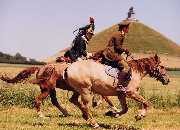 |
If reading
a large number of books on the "first
empire" provides a good understanding of history, nothing can compare to experiencing
first hand the reason for the successes and failures by re-enacting them on the same
fields and in the same manner as did the soldier of the period. This is how in May of 1999 at the re-enactment of the Campagnes of France (1814) we the French forces were compelled to make a counter attack against a German force King German Legion. at night. |
The hour and precise place were unknown to us. At 22h30 on a moonless
night, and in total darkness our cavalry patrol moved off up a narrow track which
separated
the two armies, approximately 60 men each. The stillness of the night made it
impossible for our sounds not to be discerned well ahead of us. The noise of our
own horses made listening for enemy movement difficult. The enemy infantry on
the other hand could move about in virtual silence. Score: Germans 1 French 0.We
soon arrived within range of the enemy rifles, not having any idea as to their
location. Germany 2 France 0. They began to shoot at us, their muzzle flashes
stealing their night vision and making reloading difficult. Germany 2 France
1.In good visibility we would have been able to charge them directly sabering
them all, but this was darkness and the safety of the horses was at risk.
Certainly the horses had better vision but to attack without the riders capable
of seeing obstacles would be senseless. Germany 3 France 1.Our only possibility
was to make a tactical withdrawal, calling up our infantry to handle the affair.
![]() Unfortunately we had left it too late and we would have
to owe the Germans a drink on this night.The lessons taught here showed us the
reason night action was seldom carried out by armies let alone cavalry, the
hazards being far too great.
Unfortunately we had left it too late and we would have
to owe the Germans a drink on this night.The lessons taught here showed us the
reason night action was seldom carried out by armies let alone cavalry, the
hazards being far too great.
At Athies in France during the 1814 campaign the cavalry of
Blücher was able to inflict great losses amongst the French cavalry:
The French were charged by the Prussian cavalry before they had time to form and so lost
their cohesion. The French tried to flee but were caught in a running melee. The French
infantry saw an opportunity to do great damage to the Germans overlooking the fact
that their
own cavalry were mixed in. They opened fire, hitting foe and friend alike. In darkness
it was not unusual for Prussians to shoot Prussians and French to shoot French, only the
flashes of the weapons identifying the assailants. To boot Prussians would use a ruse
shouting "Vive l'Empereur" while the French would frequently call out
"Hurrah". General Marmont rode into the masses trying to rally his
troops, as the
regiments were now mixed he had no idea how to bring them together or where the officers
were to transmit the orders.
Meanwhile Colonel Fabvier, detached one hour
earlier, hears the hurrahs
of the Prussians and brings up 1000 infantry in support. His surprise intervention clears
the road and brings stability to the situation, acting as a rallying point for the French
cavalry.
![]() Marmont is now able to put some order in the situation and carry out an orderly
withdrawal. French losses are huge: 3000 out of 9000 are killed, wounded or lost.
Marmont is now able to put some order in the situation and carry out an orderly
withdrawal. French losses are huge: 3000 out of 9000 are killed, wounded or lost.
Night fighting was not recommended. Even in daylight there could be
difficulties i.e. the color of many uniforms looked similar, Saxons fought for the French
and also for the Austrians using the same nobleman's name to identify their
regiments. Many other examples can be used.
From General de Brack's book the "Light cavalry out posts"
we can understand the uses of cavalry action at night:
If the Cossacks attack, the wish is to keep the enemy awake causing exhaustion.
If the Prussians attack, it is more serious and you must be ready and able to
manoeuvre.
If the Austrians attack, they probably have their infantry with them.
Historical
list of 2nd
Dragoons'Colonels under Napoleon
And list of
Wunded and died officers. on
french special page
![]() HOME
HOME
Clic to ADD
www.2dragons.be
to your Favorites